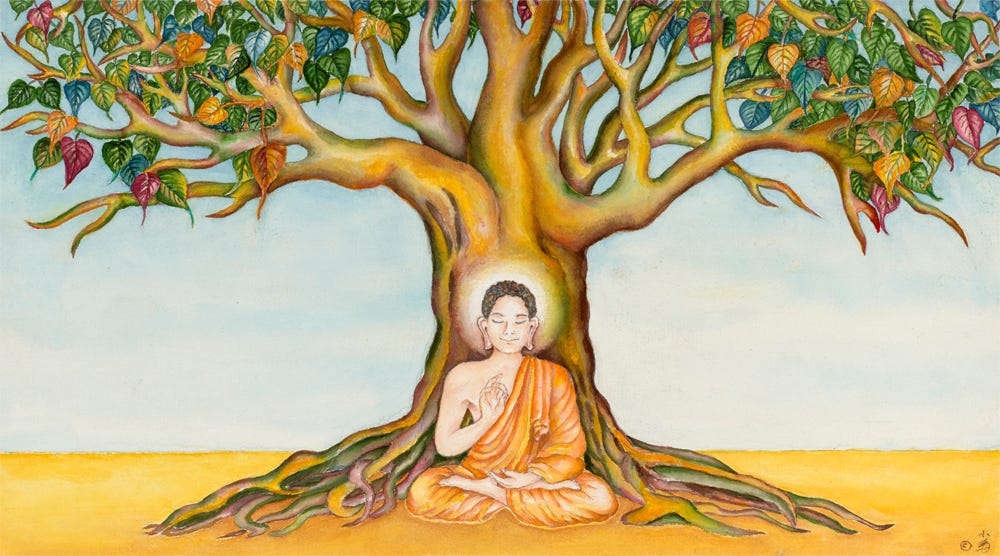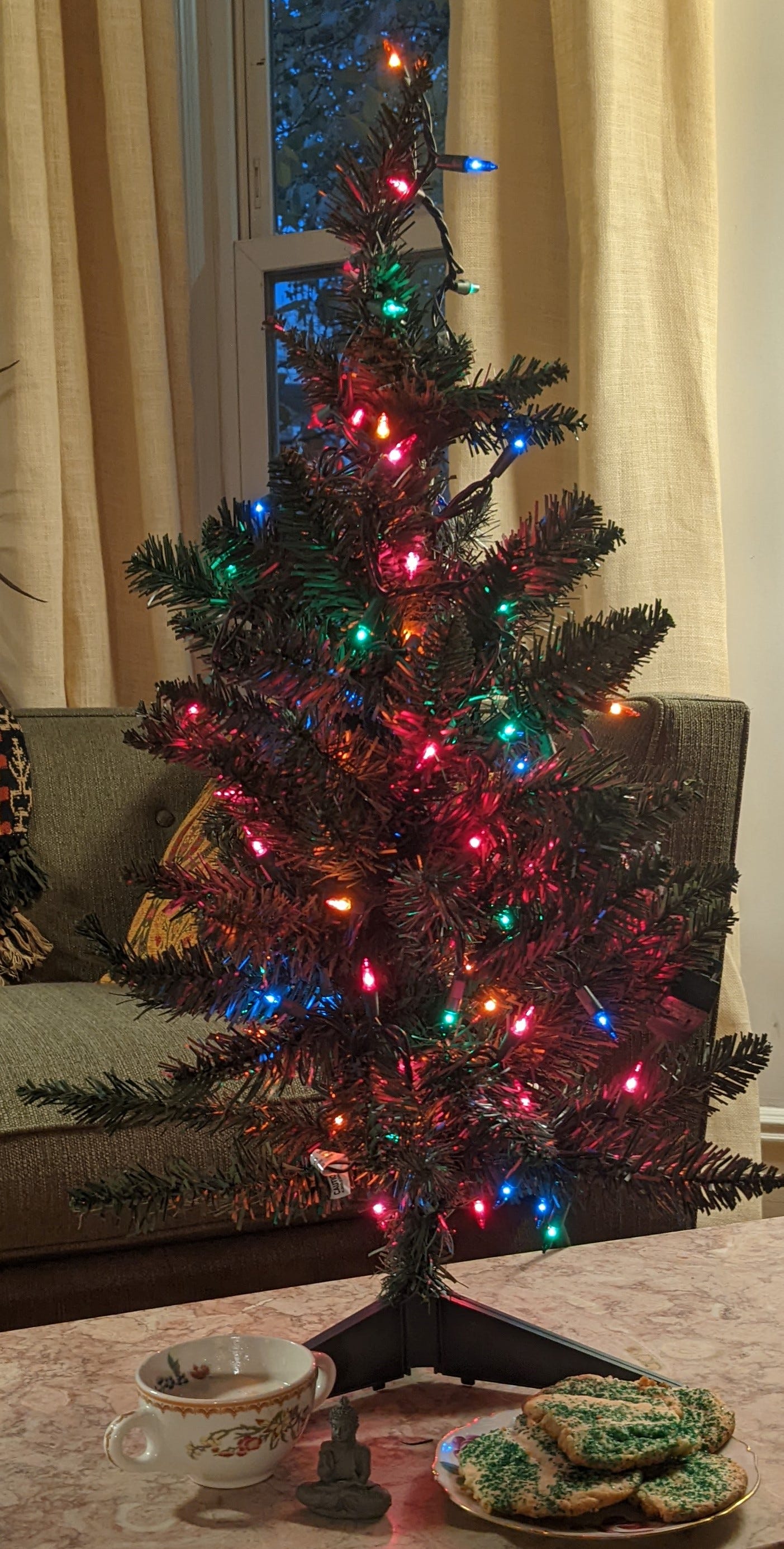The Enlightenment Tree
Bohdi Day is here!
A young man comes to rest under the cool sheltering arms of a gigantic bodhi tree. He has been traveling for what seems forever, seeking a way to alleviate the suffering he sees everywhere around him. But the way has proven elusive. He decides to try one more time through relinquishing his own body. For 48 days he sits under the tree and fasts even though the villagers, watching his body waste almost to the point of disappearing, beg him to stop. A single grain of rice is all he will eat. And then, on the 49th day, the young man becomes infused with the certainty that he’s discovered a path forward that will lead to being free from all the hardships of life’s afflictions. He is enlightened. He has transcended. He is The Buddha.
This is what Bodhi Day honors—The Buddha’s discovery of a release from Dukkha—the darkness that propels life’s anguish.
I think we can all agree that today’s world is steeped in Dukkha. We are, as The Buddha explained in The Four Noble Truths, overwhelmed by the hellish facts of the world we’re experiencing right now, caught up in a cycle of ravenous dissatisfaction that doesn’t permit us to see how to break free. But The Buddha teaches us there is a way to turn from the endless circle of despair and toward a liberating awareness of a more purposeful existence.
I am not a Buddhist. I grew up steeped in Catholicism—12 years of Catholic schooling, nuns and priests in the family—and fell out of grace when I turned a sardonic 18. Until I dove into Bodhi Day, my only brush with Buddhism was through a meditation practice begun years ago as part of a treatment for a long illness. It has since become a necessity in my life. I kept reflecting on this through the last few days while reading The Buddha’s teachings.
Bodhi Day shares a lot with Christmas. They each mark the birth of a great leader whose life brought a new order into the world. They are days to reflect on the significance of the men’s lives and how their teachings seek to lead people to a more meaningful life.
The two feasts even share ways to celebrate, beginning with a brightly lite tree. One of the meanings Christians have pinned to evergreen trees aglow with lights is that it represents Jesus and the light he brought into the world. For Buddhist, the decoration of a bodhi tree with multicolor lights symbolizes the tree that harbored The Buddha and each blazing color binding its branches illustrate the different roads one may travel toward enlightenment. The tree is usually a ficus trees because the bodhi tree is in the same plant family. But any old tree will due, including my sorry little fake one. If you have a statue of Buddha, place it under the tree.

Food is also as central a tradition to Bodhi Day as it is to Christmas. First, there are cookies, although Bodhi Day’s keep to two shapes—either in the form of a tree or a ficus leaf. Since there were no cookie cutters except for snowflakes, stars, and reindeer around my house, I went freehand. I used a butter cookie dough, but any dough will do. Mine are as imperfect as my tree but following The Buddha’s teaching I let go of worldly concerns. This is more than fine on Bodhi Day for it encompasses compassion, not judgement (I love this holiday!).
The most important dish is a bowl of milk rice, the very thing that The Buddha received to break his fast. It seemed to me at first that a thin gruel would be closest to what revived The Buddha. That makes sense, at least in Western culture, because it is one of the nourishing foods first given to convalescents. For that you soak rice in water, drain, then add milk and slowly cook it for as much as an hour, at which point the rice will almost be dissolved enough to sip rather than slurp with a spoon.
But The Buddha was not in the West, and Eastern traditional milk rice recipes tend to lean toward the Indian version of a sweet rice pudding with the addition of aromatic spices, usually cardamom. I found one on a site exclusively about Bodhi Day.
And now, here I am, sitting at the end of the day with a plate of cookies and a bowl of milk rice, gazing at the colors on my makeshift tree. A tall Christmas tree, branches bowed by a multitude of colored blinking lights will join it soon and there will be more cookies and a bowl of Christmas pudding. They will all help me count the ways to vanquish Dukkha and achieve enlightenment in the coming year.
Mrs. Hanamoku’s Bodhi Day Rice and Milk
On the Bodhi Day website, the recipe notes that: This desert can be served warm like oatmeal or cold like custard. I prefer it warm like oatmeal since I have this after I return from an [sic] really cold time outside doing my Bodhi Day thing. It’s nice to make enough to have it again cold for desert at the end of your first day of enlightenment.
In a personal note, I will add that, on this gray, cold day with snow in the offering this afternoon, I poured a little rice milk into a bowl, added a handful of raisins, then microwaved it for 1 minute. Made me infinitely more capable to cheerfully greet the day.
4 cups whole milk
½ cup rice – Basmati, Jasmine, or Japanese Sticky rice.
½ cup sugar
2 teaspoons cardamom powder or mashed 2 cardamom pods
Wash and soak the rice for 30 minutes then drain and put aside.
Bring milk to a boil in a small saucepan.
Add the rice to milk and bring to a simmer. Cook, uncovered, over medium heat, stirring occasionally until the rice is leaning towards the mushy side.
Add sugar and continue to cook until mixture thickens, about 5 minutes more. Keep stirring to make sure it doesn’t burn.
Add cardamom and cook for 5 more minutes.
Note: Bodhi Day is celebrated on different days in other Buddhist branches depending on the calendars they use.




Love this so much! I think that we should all celebrate the month of December as the Festival of Lights (to borrow from the Jewish culture). There are so many cultural festivals and celebrations that usher the light back during this season. What a brilliant place this would be!